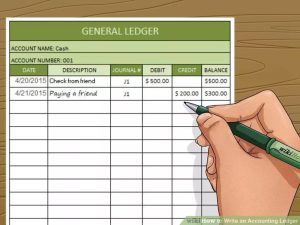What is a General Ledger
A general ledger is a core component of a company’s accounting system, used for tracking and recording all financial transactions. It serves as a central repository for all the company’s financial information and plays a fundamental role in the financial reporting and management of an organization. Here are key aspects of a general ledger:
Record-Keeping: The general ledger is used to record all financial transactions, such as sales, purchases, expenses, and various other financial activities. Each transaction is documented in a specific account within the ledger.
Double-Entry Accounting: The general ledger employs double-entry accounting, which means that for every financial transaction, there are at least two entries: a debit and a credit. This ensures that the ledger remains in balance.
Chart of Accounts: A chart of accounts is a structured list of all the accounts used in the general ledger. Accounts are categorized and organized to reflect the company’s financial structure. Common account categories include assets, liabilities, equity, revenue, and expenses.
Posting Transactions: Once a financial transaction occurs, the details are entered into the appropriate accounts in the general ledger. Debits and credits are used to reflect increases or decreases in account balances.
Trial Balance: Periodically, account balances are summarized in a trial balance to ensure that the total debits and credits in the ledger are in balance. If they are not equal, it indicates an error that needs correction.
Financial Statements: The data stored in the general ledger is used to prepare various financial statements, including the balance sheet, income statement, and cash flow statement. These statements are essential for reporting the company’s financial performance and position.
Audit Trail: The general ledger provides a comprehensive audit trail, allowing financial transactions to be traced and verified. This is crucial for internal and external auditing, as it supports transparency and accountability.
Historical Record: The general ledger serves as a historical record of financial activities, making it possible to analyze past performance and trends, which is vital for decision-making and planning.
Software and Technology: In modern accounting, general ledgers are often managed through accounting software and Enterprise Resource Planning (ERP) systems, which automate many aspects of transaction recording and reporting.
Reconciliation: Reconciliation is the process of comparing the balances in the general ledger to those in subsidiary ledgers or external records, ensuring that they match and are accurate.
Importance of a General Ledger
The importance of a general ledger cannot be overstated. It serves as the foundation for all financial reporting, making it an essential tool for decision-making, auditing, and compliance. Without an accurate and up-to-date general ledger, a business would be navigating in the dark, financially speaking. Don’t forget to visit our website globallbrowse.com
Components of a General Ledger
Chart of Accounts
A crucial element of the general ledger is the chart of accounts. This is a list of all accounts a business uses to record its financial transactions. Each account is assigned a unique code and description for easy reference.
Journal Entries
Journal entries are the individual transactions that are recorded in the general ledger. They are like the building blocks that make up the ledger. Each journal entry contains the date, description, and the amount of the transaction.
Debits and Credits
Debits and credits are the language of accounting. Debits represent money going out of an account, while credits represent money coming into an account. Understanding this fundamental concept is key to maintaining a balanced ledger.
How General Ledgers are Used
Tracking Financial Transactions
One of the primary functions of a general ledger is to track financial transactions. It provides a detailed history of all money movements within a business, making it easier to spot trends and anomalies.
Preparing Financial Statements
The data from the general ledger is used to prepare financial statements such as the balance sheet, income statement, and cash flow statement. These statements are critical for evaluating a company’s financial performance.
Auditing and Compliance
General ledgers play a vital role in auditing and ensuring compliance with accounting standards and regulations. An accurate ledger simplifies the audit process and helps businesses meet legal requirements.

The General Ledger in Accounting Software
Advantages of Digital General Ledgers
With the advent of accounting software, general ledgers have gone digital. This transition has brought several advantages, including real-time updates, automation, and enhanced data security.
Popular Accounting Software
There is a wide range of accounting software available, each with its own features and capabilities. Popular choices include QuickBooks, Xero, and FreshBooks, which cater to businesses of all sizes.
Best Practices for Maintaining a General Ledger
Regular Reconciliation
Reconciliation involves comparing the data in the general ledger with external records, such as bank statements. Regular reconciliation helps identify discrepancies and errors.
Data Accuracy
Maintaining data accuracy is paramount. Errors in the general ledger can have far-reaching consequences, so it’s crucial to double-check entries and calculations.
Data Security
Given the sensitivity of financial data, data security is a top priority. Protecting the general ledger from unauthorized access and cyber threats is essential.
Common Errors in General Ledger Maintenance
Reversing Entries
Reversing entries can be problematic. They are used to correct mistakes but can introduce new errors if not done correctly.
Posting to the Wrong Account
Posting transactions to the wrong account can distort the financial picture, leading to incorrect decisions.
Not Balancing the Ledger
Balancing the ledger ensures that debits and credits match. Failing to do so can result in inaccuracies.
The Evolution of General Ledgers
From Manual to Digital
General ledger accounting has come a long way from manual record-keeping to modern digital systems. This transition has made accounting more efficient and accessible.
Challenges in General Ledger Accounting
Scalability Issues
Growing businesses face challenges in scaling their general ledger systems to handle increasing volumes of data.
Integration Challenges
Integrating the general ledger with other business systems can be complex and requires careful planning.
Case Studies: General Ledger Implementation
Small Business
We’ll explore how a small business successfully implemented and maintained its general ledger system to drive financial growth.
Large Corporation
A case study of a large corporation’s general ledger system, showcasing the complexities of managing vast financial data.
General Ledger in Personal Finance
Budgeting and Tracking Expenses
General ledger principles aren’t just for businesses. We’ll discuss how individuals can benefit from using similar techniques for personal finance.
Conclusion
In conclusion, the general ledger is the cornerstone of a company’s financial records. Its accuracy and integrity are paramount for sound financial decision-making. Whether in the world of business or personal finance, understanding the general ledger is key to financial success.
FAQs
What is the primary purpose of a general ledger?
The primary purpose of a general ledger is to record and track all financial transactions of a business.
How has the general ledger evolved over time?
The general ledger has evolved from manual record-keeping to digital systems, enhancing efficiency and accessibility.
What are some common errors in general ledger maintenance?
Common errors include reversing entries, posting to the wrong account, and failing to balance the ledger.
Why is data security crucial for a general ledger?
Data security is essential to protect sensitive financial information from unauthorized access and cyber threats.
How can individuals use general ledger principles in personal finance?
Individuals can use general ledger principles for budgeting, tracking expenses, and managing personal finances effectively.







